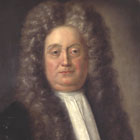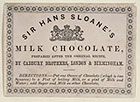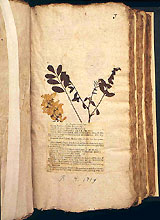Sir Hans Sloane
Sir Hans Sloane was a doctor who collected curiosities with a passion. Although he always hoped society would benefit, he would be astonished at the scale of the enterprise he started.

Sir Hans Sloane (1660-1753).
Hans Sloane was one of the great men of early 18th-century London, a wealthy and popular physician to high society and royalty. But it was the natural sciences, especially botany, which fired his interest.
In his long life, he amassed one of the greatest ever private collections of plants, animals, antiquities, coins and other curios. It was to be the founding core of the British Museum and later the Natural History Museum.
Video
Watch this video to find out about Sloane’s time as a physician in Jamaica, where he made an incredible collection of plants and animals, and investigated new medicines. Discover one of the Museum’s celebrity specimens - collected by Sloane - and how it has touched each and every one of us.
Read the Work and Timeline sections for more detail about Sloane’s life, and learn how he came to be the founding father of this Natural History Museum.
You need Adobe Flash Player, or an HTML5 enabled web browser, and JavaScript enabled to watch this video.
Visit the Adobe website to download the latest Adobe Flash Player
Work
Journey to Jamaica
Born in 1660, Sloane was inspired to study medicine by his love of natural history. At the age of 27, the young doctor was given an opportunity that was to change his life forever.
He was invited to accompany the new Governor of Jamaica, the Duke of Albemarle, as his personal physician. Sloane accepted and set sail for the Caribbean.

Sloane's trade card for Milk Chocolate.
Sloane travelled extensively around Jamaica. An enthusiastic and skilled naturalist, he took notes on everything he saw - the weather, earthquakes, the island's geology and local customs. He also collected plants, animals, shells and rocks.
Introducing chocolate
Among his specimens was the fruit of the cocoa tree. Sloane learned that the Jamaicans mixed the cocoa beans with water to create a drink.
Although he considered it wholesome, Sloane found the cocoa 'nauseous' but discovered that it improved when mixed with milk. Back in England he introduced the recipe as a comforting remedy, later adopted by Cadbury.
Natural history of Jamaica
Sloane returned to England following the Duke's death in 1688. He brought with him over 800 plant species and a menagerie of live specimens. Some never made it – an iguana fell overboard, and a snake over 2m (7ft) long escaped from its jar and was shot by a servant.
Sloane later produced a 2-part account of his Jamaican experiences, the Natural History of Jamaica. These volumes greatly enhanced his reputation as a scientist and the Royal Society elected him President in 1727.
A man of many talents
Once back in London, Sloane set up a lucrative medical practice in fashionable Bloomsbury. With his charm and intelligence, he attracted a prestigious clientele, including royalty. Sloane became famous as a physician and a philanthropist, but most of all as a collector.
Sloane's Jamaican adventure had begun his life's work. Through gifts and purchases he acquired thousands more plant species. But Sloane cast his collecting net much wider than botany. Along with natural objects he amassed a vast assortment of other treasures and curiosities.
Sloane's collection filled the corridors and rooms of his home from top to bottom. Eventually he bought the house next door just for extra storage space. In 1742 he moved to a manor house in Chelsea. There he continued diligently adding to his hoard until he was over 90 years old.
'His great house in Chelsea is full throughout, every closet and chimney, with books, raritys, etc.' (William Stukeley, 1743)
Birth of a museum
Sloane's private museum was visited by a stream of connoisseurs from Britain and abroad. He welcomed visitors openly, motivated by a strong sense of public utility and also by his firm Christian beliefs.

Plate from Sir Hans Sloane's botanical collection, held at the Museum.
The sheer size of Sloane's collection was astounding. By the time of his death his herbarium had grown to fill 265 huge, leather-bound volumes. His zoological collections contained over 21,000 specimens ranging from birds' eggs to grisly human relics.
Alongside these was a massive hoard of fossils, gemstones, rocks, minerals, ores, metals, medals, coins and antiquities.
But the library was perhaps the crowning glory. It contained almost 50,000 bound volumes, and an impressive collection of manuscripts and drawings.
Sloane ensured, through his will, that his collection would continue to delight and inform the public. He appointed 60 trustees to request King and Parliament to buy his collection for the nation for the low sum of £20,000, payable to his 2 daughters.
The British Museum Act (1753) raised the money for the collection and a new home for it. At this time there was no model in England, or indeed in Europe, for such an institution.
Sloane hoped his collection would be the nucleus of a major national public museum, but even he could not have guessed at the scale of the enterprises that resulted - the British Museum and Natural History Museum, with their millions upon millions of objects and books.
'[my curios]...may remain together and not be separated and that chiefly in and about the city of London, where I have acquired most of my estates and where they may by the great confluence of people be most used.'
Timeline
| 1660 | Born 16 April in Killyleagh, County Down, Northern Ireland. |
|---|---|
| 1660 | Charles II becomes king. |
| 1666 | The Great Fire of London. |
| 1679 | Arrived in London to study medicine. |
| 1683-84 | Studies in Paris and Montpelier and attends botanical and anatomical lectures given by leading scholars. |
| 1684 | Returns to London and becomes friends with leading scientists and intellectuals of the day including the physicist Robert Boyle, botanist John Ray, Christopher Wren and Samuel Pepys. |
| 1685 | Elected member of the Royal Society. |
| 1687 | Elected member of the Royal College of Physicians. |
| 1687 | Travels to Jamaica as physician with the Second Duke of Albemarle, the new Governor of Jamaica. |
| 1689 | Returns to London. |
| 1695 | Marries Elizabeth, a wealthy widow. |
| 1696 | Catalogus Plantarum (catalogue of Jamaican plants) published. |
| 1707 | Publishes first volume of the Natural History of Jamaica. |
| 1716 | Receives a knighthood. |
| 1719 | Made President of the Royal College of Physicians. |
| 1722 | Made Physician-General to the Army. |
| 1722 | Leases four acres of land to the Society of Apothecaries for £5 a year in perpetuity for the Chelsea Physic Garden. |
| 1725 | Publishes second volume of the Natural Historyof Jamaica. |
| 1727 | Made President of the Royal Society. |
| 1727 | George II takes to the throne. |
| 1735 | Linnaeus suggests a new system of classifying living organisms that will soon become standard practice. |
| 1739 | Makes his will, later revised to express the desire that his collections should stay together. |
| 1742 | Retires to Chelsea Manor House after serious illness. |
| 1743 | Moves collections to Chelsea from Bloomsbury Place. |
| 1750 | Start of the Industrial Revolution. |
| 1753 | Sloane dies 11 January at Chelsea, aged 92. |
| 1759 | The British Museum opens. |